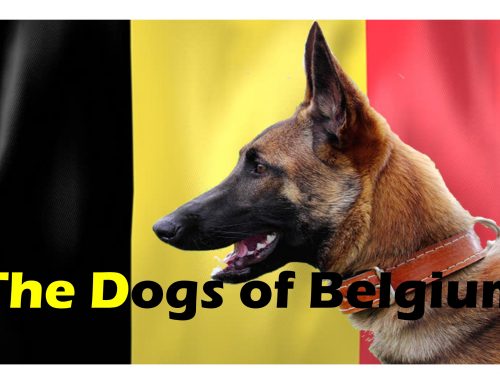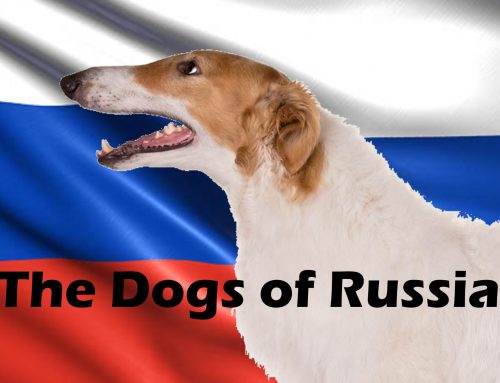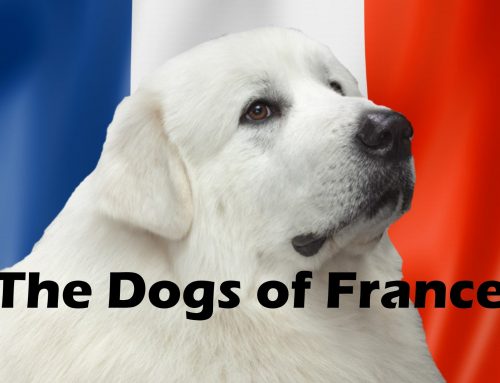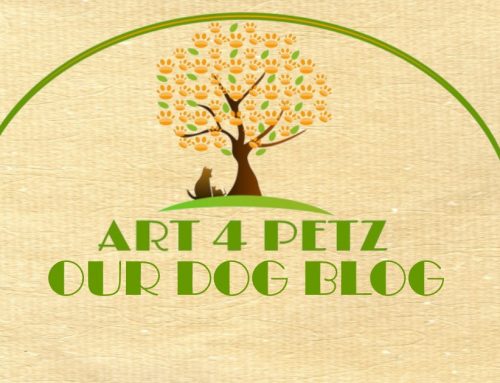Italy is a beautiful county with marvellous land and seascapes. The people of Italy are warm generous and family oriented and are extremely good looking. If I do say so myself! And they are big dog lovers! In fact, in Italy dogs are allowed to accompany their owners into restaurants the most fashionable of stores, such as Prada.
You will see many dogs from around the world in Italy but here are a few that are part of Italian history:
Bergamasco Shepherd
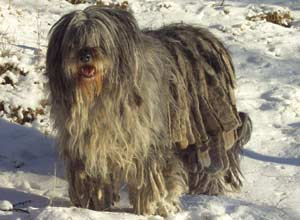
The Pastore Bergamasco (Bergamasco Shepherd) is a very unique dog with a heart of gold. They are known for their independent spirits, excellent intelligence, and great herding skills. Despite all those wonderful traits, probably the most well-known feature of the Bergamasco is their felted coat. These shaggy dogs originated over 2000 years ago in Persia.
The Bergamasco has its origins in the Italian Alps near Bergamo. Originally used for herding, it is still used for herding cattle and sheep in the Italian and Swiss Alps.
The Bergamasco’s most distinctive feature is its coat, which has three types of hair: a fine dense and oily undercoat, long harsher hairs and a top woolly outer-coat. This unique coat evolved from living in a cold mountainous area.
The breed faced extinction in the 1950s because after World War II the need for wool, and hence sheep, declined, meaning fewer Bergamasco dogs were required as working dogs. An Italian breeder, Maria Andreoli, made efforts to save the breed, although it is still rare. There are an estimated 600 Bergamasco dogs alive today but their numbers are declining.
Bolognese

The Bolognese is named after the city of Bologna where the breed is thought to have originated. The breed dates to Ancient Roman times and is depicted on Roman earthenware. Images of the breed also appear on 17th-century Flemish tapestries, and in paintings by Francisco Goya, Antoine Watteau and Nicolas Gosse. The Italian artist Titian famously painted a portrait of Federico II Gonzaga, Duke of Mantua with his pet Bolognese c. 1529, which now hangs in Madrid’s Museo del Prado.
The Bolognese is small dog that belongs to the Bichon family. It grows up to 12 inches high and weighs up to 14 pounds. It has long, fluffy white hair that falls in loose, open flocks like ringlets over the body. The average life span of the Bolognese is 14 years.
It was popular among ladies and Italian Aristocracy in the past. Despite its small size and pleasant personality, The Bolognese is very rare breed today. It is rarely seen even in the country of its origin.
Cirneco of Etna

The Cirneco dell’Etna is one of the world’s oldest dog breeds and is one of the few breeds that acquired its modern characteristics through natural selection not human intervention. These dogs adapted to hunting in a harsh environment that was hot and dry, with rugged terrain formed by volcanic lava.
(Cirneco of Etna) is a small, slender breed of hunting dog that looks similar to a greyhound. A rabbit hunter by trade, the Cirneco is originally from Sicily, where it was bred to endure the harsh terrain of Mount Etna.
The Cirneco do not hunt by scent, like most dogs do. Instead they primarily use site and speed. Their lean bodies make them extremely fast, able to chase down rabbits and other small game.
The Cirneco was named for Mount Etna, Europe’s highest active volcano. There is a legend that 1,000 Cirnechi used to guard the temple of the god Adranos, located on the southwestern slope of Mount Etna. According to the legend, the Cirnechi had the divine ability to recognize thieves and non-believers among those who approached the temple.
It is one of the smallest breeds of hunting dogs measuring up to 20 inches high and weighing up to 26 pounds. It has a shorthaired coat that is light to dark tan in color.
Cane Corso – Courser

The Cane Corso, otherwise known as the Italian Mastiff, is the descendant of dogs used by the ancient Romans in warfare as well as guarding livestock and hunting game. It derives its name from the Latin ‘cohors’, meaning ‘protector’.
Carters and drovers have also used the Cane Corso to pull carts. At one time the breed was common throughout Italy but in the recent past they have been limited to parts of southern Italy such as Apulia, Basilicata, and Campania. Images of the Cane Corso have been found all over Italy. The breed has often been mentioned in Italian poetry.
A muscular dog, it stands 28 inches high and weighs up to 150 pounds and has a black or fawn shorthaired coat, sometimes with white markings. The average life expectancy is 11 years.
In terms of personality the Cane Corso is a smart, trainable dog. They have a noble bearing and they are excellent protectors. They are assertive, confident dogs. They are normally eager to please their owners and quite docile at home. They make an affectionate, loyal family dog.
Italian Pointer – Bracco Italiano
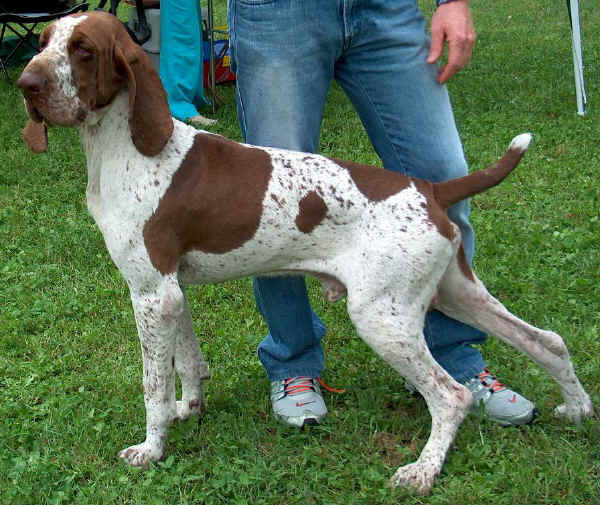
The Bracco Italiano (Italian Pointer) was bred as a hunting dog and has ancient roots in Italy and is mentioned in writings of the 4th and 5th centuries. Images of the Bracco appear in 14th-century frescoes and engravings, and the dog was bred by the illustrious Medici and Gonzaga families during the Renaissance when hunting birds was a sport favoured by the Italian aristocracy. The dogs were so highly prized that records show that a chestnut Bracco was given as a gift to the French Royal Court in 1527.
In his native Italy, the Bracco Italiano is known as a hunting dog first to drive birds into nets and then as a gundog, but he’s also gaining notice as a sweet and affectionate family pet. With his long ears, droopy lips, and soulful expression, the Bracco Italiano has a distinctive look. He’s believed to be an ancient breed, dating back to the fourth or fifth century B.C.
The Bracco is thought to have developed from a cross between the white and orange Piedmontese Pointer, and the white and chestnut Lombard pointer. The Bracco faced extinction in the late 19th century, but was saved thanks to the efforts of Italian breeder Ferdinand Delour de Ferrabouc.
Braccos look like Bloodhounds with solemn faces. They are mottled in appearance with coloured patches, often white and orange, or white and brown, but also with chestnut and amber markings.
Italian Spinone

The Spinone Italiano has always been near and dear to Italy, but only made a splash in the United States recently.
The Italian Spinone is one of the oldest pointing breeds of gun dogs. The provenance of the breed is uncertain but some think it was brought to Italy by traders from Greece and the western Adriatic coast during Ancient Roman times.
The Spinone is believed to be named after an Italian thorn bush, the spino, which was a hiding place for small game seeking shelter from larger predators. The wiry-haired Spinone was able to penetrate the prickly bush and is known for being able to hunt in dense cover, and both retrieve and track on water. After World War II, the breed faced extinction but was saved thanks to the efforts of Italian enthusiasts.
One of the reasons the Spinone is touted as such a great hunting dog is that it is both a pointer and a retriever. A pointer uses his muzzle to point toward the game, while a retriever will jump in the water to retrieve birds that a hunter has shot. Because he plays both roles, the Spinone is particularly valuable to a hunter.
Spinone are large dogs that can weigh up to 86 pounds and reach up to 28 inches in height. They are strong with a wiry coat, rough beard and large nose. Their coats are usually white, white with orange or chestnut markings, brown roan with brown patches, or orange roan with orange patches. The average life expectancy of a Spinone is nine years.
Maremma Sheepdog

A Maremma is a livestock guarding dog, bred in Italy for centuries to guard large flocks of sheep on the plains and in the mountains. Other Old World breeds with similar temperament are the Great Pyrenees in France, the Komondor and the Kuvasz in Hungary, the Tatra in Poland, the Shar Planinetz in Yugoslovia, the Anatolian and Akbash in Turkey, and the Tibetan Mastiff in Nepal and Tibet.
The Maremma originally lived day and night with its flock, and its white coat mimics the coat of the sheep in its flock. It was bred to take responsibility for keeping the flock safe from 4-legged predators, primarily the wolf, and from 2-legged thieves; and kept proficient at its job by frequent life-and-death battles with the wolves.
Similar to the Great Pyrenees in looks, size and temperment, the Maremma Sheepdog is very affectionate! They want to know where all family members are and to be close to them. The dogs lean on you, body block you, paw you; and some even want to hug you or nibble you affectionately. They do not fawn on you, and certainly not on strangers, for attention; but they demonstrate constantly, their deep devotion to their bonded intimates.
On the average, adult males are a bit larger than bitches and average 27 inches tall and weigh 75 to over 100 pounds, while bitches average 26 inches tall and weigh 66 to 88 pounds.
Neapolitan Mastiff

The Mastino Napoletano (Neapolitan Mastiff), or Italian Mastiff, is thought to be descended from dogs used by the Ancient Romans during their campaigns across Europe. A large, muscular dog with a large head, powerful jaw, short strong legs weighing as much as 200 pounds and measuring 30 inches high, the Romans used Neapolitan Mastiffs as guard dogs. The Romans also trained Neapolitan Mastiffs as gladiator dogs to fight in wars, and in amphitheatres to bait bears, bulls and even jaguars.
The Neapolitan Mastiff is powerful, furious, aggressive and energetic large breed who are dangerous to their enemies. They have loose skin covered with wrinkles and a shiny coat. They are also known as Molosser type of dogs. It is also known that this breed is a warrior, chivalrous and brave in nature.
These dogs were famous in Europe after World War II and the breed faced extinction after the war ended, but was saved when Italian painter Piero Scanziani set up a breeding kennel in Rome in 1949. Lovers of the Neapolitan Mastiff often refer to the breed simply as ‘Neo’.
The life expectancy of a Neapolitan Mastiff is seven to nine years. They are short haired, and black, brown or grey in colour.
Volpino Italiano

Volpino Italiano means ‘little Italian fox’. It is a spitz breed with long, thick fur, a curly tail and small, pointed ears. The breed dates back thousands of years, and was loved by aristocrats and peasants alike – it is even thought that Italian artist Michelangelo had a Volpino.
In 1965, only five Volpino were known to exist but a project was founded to save the Volpino breed using animals used as guard dogs on farms. There are thought to be a few thousand Volpino alive today.
The Volpino Italiano has, for nearly a thousand years, kept company with a wide range of people—from princes to farmers, from merchants to artists. So, this dog is perfectly at ease guarding animals on a farm or relaxing on the couch. While lively, friendly and fun, it can be slightly protective. If the Volpino Italiano senses something suspicious, it will definitely deliver the barks.
Though protective, the Volpino is not especially clingy with family members. Intelligent, busy and curious, it has a lovable sense of independence. But it truly craves your attention and affection. Start the training and socialization early, and your Volpino will provide years of upbeat companionship.
The Volpino is usually white, black, champagne or red in colour. It weighs up to 12 pounds and has an average height of 11 inches. A Volpino has an average life expectancy of 15 years.
Dogs are the only species that love us more than they love themselves.


